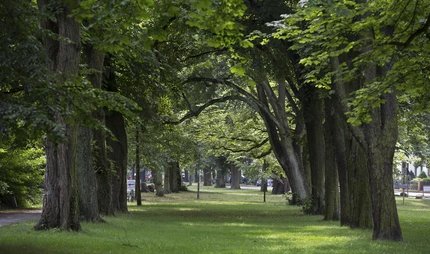
Green Trail Tempelhof-Schöneberg
Berlin's generosity
The small oases between buildings and streets, where you can go for a walk, read and play, are what give the city air to breathe.
Bosepark was built in 1914 by the district of Tempelhof. In addition to walks and a charming playground, it also offers an insight into Tempelhof in days gone by. If you look a little closer, you will find weathered grave stones on nearby Stolbergstraße.
Lehnepark is right next to the churchyard of Tempelhof’s picturesque old village church. Along with the many old graves, you will also come across a memorial stone to remember Berlin’s victims of the 2004 tsunami in Southeast Asia. One of the botanical highlights that the park has to offer is a real bald cypress growing on the edge of a small pond.
We then move to the connecting Alter Park which covers an area of almost 4 hectares. The elliptically shaped lake, formed by ice from a glacier, is the most dominant feature of this park. Alter Park was acquired by the district as far back as 1907 and opened just one year later as a community park. Today, the park still boasts gentle slopes, a large lake and a pretty abundance of shrubs and trees.
Looking across the wide road of Tempelhofer Damm, it appears as if the green corridor has come to an end, but if you look further, beyond the town hall car park, it reappears as Franckepark, developing further into woods with a very special attraction: a large deer enclosure is located in the centre of the park, offering education about nature for city children. It is great to watch from the two elevated viewing platforms.
Franckepark is named after its founder, arboretum owner Theodor Francke. Together with Jonathan Kaehler, he planned the park which was finally built in 1875 with features that even included a sledding hill for his children. In the 1920s, the park was redesigned. The existing trees remained and continue to create an enchanted forest atmosphere right in the middle of this city park.

